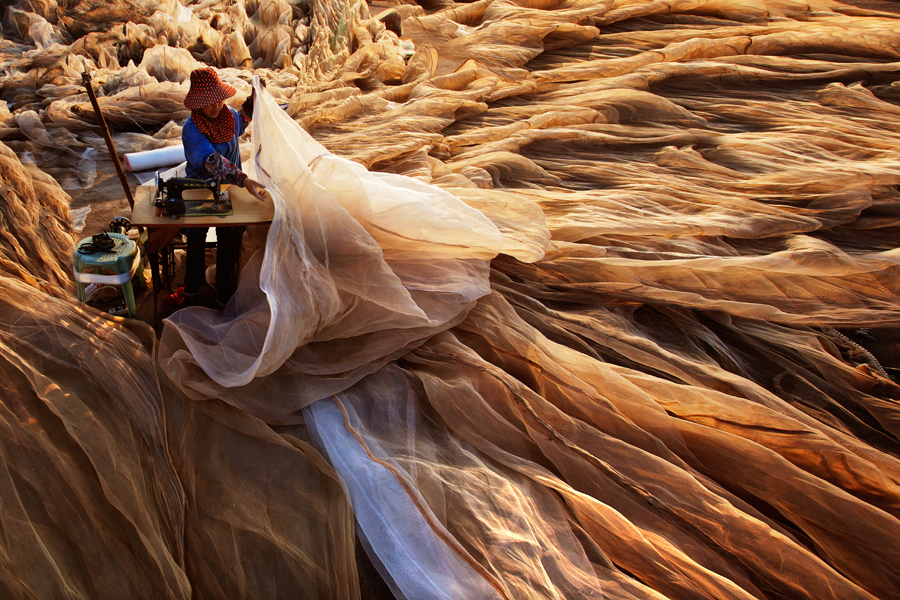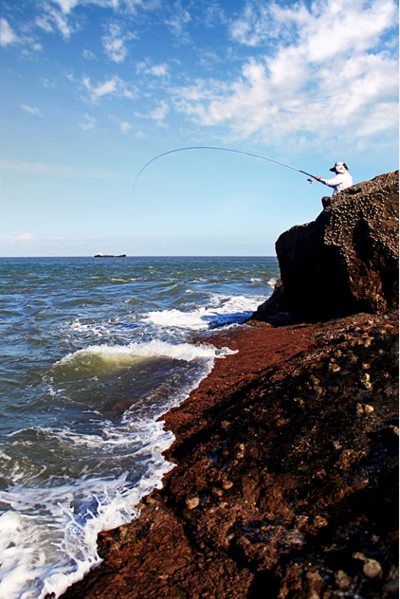
A story has been given to a pile of rocks on Dongtou’s coast. The higher rock on the left has a shape of the Avalokitesvara, who is taming a lion on the right.[Photo provided to China Daily]
For a person who has just escaped smog-choked Beijing, the weather in Dongtou is a blessing — bright sunshine, crystal clear air and a moist breeze. But Zhao Xiangwu, a 56-year-old local fisherman, tells me it is just a typical day in the island county, 30 kilometers offshore from Zhejiang’s Wenzhou city.
“You should come again in July. The sky will be even more blue in summer,” Zhao says on his way to collect oysters on the beach. A bamboo basket hangs from his waist.
“But then the beaches will be packed with tourists,” he laughs. “Dongtou is becoming famous.”
Local’s call Dongtou “a county of a hundred islands”. More precisely, it has 168 islands. Fourteen of them are inhabited and are home to more than 130,000 people. The five largest islands are connected by highways that stretch across the water.
After landing in Wenzhou, it takes me one hour to drive to the islands. In the dusk, a thick mist drapes the highways and islets on either side of me, giving the county a mysterious look.
I thought the mist only appeared in the dusk, but the next morning when I climb the Wanghai Tower, or Sea-watching Tower, an ancient structure located on the highest mountain on the county’s largest island and the highest point of Dongtou, I find all the islets still covered with mist. They are like leafy mountain peaks, and the ocean like the layer of cloud hiding the mountain’s massive bottom.

The Wanghai Tower, or Seawatching Tower, an ancient architecture that is located on the highest mountain on the county’s largest island, and also the highest point of Dongtou in December, 2012. [Photo by Chen Yufa/For China Daily]
The 35-meter-tall tower is Dongtou’s landmark and its top floor offers the best view in the county: a 360 degree view of ocean and islands.
It was first built in 434, by Yan Yanzhi, a writer and a local administrator. Yan was impressed by Dongtou’s ocean view when he first visited the island and later built a tower so every time he visited the island he could enjoy the view. Four hundred years later, another writer, Zhang Youxin, who was also a politician, visited the tower’s remains and wrote a poem: “What a stunning view of the green peaks surrounding by waters. The tower built by an ancient sage can’t be found. What a shame! Endless waves are the only things left.”
Zhang’s poem was included in the A Complete Collection of Tang Poetry, the largest collection of poetic masterpieces written by poets in the Tang Dynasty (618-907), and it spread Dongtou’s name across China.
In 2003, the Dongtou administration decided to rebuild the tower to encourage tourism and when the tower opened to the public in 2007, it quickly became the most famous sightseeing spot in the county.
Compared with other island tourist destinations, including Hainan and Fujian’s Xiamen, Dongtou is less known but increasingly attracting more visitors.

Seagulls in Dongtou.[Photo provided to China Daily]
Nearly 6 billion yuan ($0.9 billion) has been invested in the tourism industry. In 2013, it won the title of “Zhejiang’s 10 best vacation destinations”. In 2014, it received nearly 4 million tourists, up from 3.6 million in 2013, and the consolidated income of the tourism industry grew to 1.8 billion yuan, from 1.6 billion in 2013.
The second most popular site in Dongtou is called Xiandieyan, or “rocks piled by gods”. It is a large range of rocks piled up like toy blocks on the east coast of Dongtou’s biggest island. Artists had painted a Buddha on the steep slope of rocks and the site has become a place where people practice Buddhism.
In addition to the five largest islands, many of the smaller of Dongtou’s 168 islands are worth visiting by boat. One of the islets is called Zhuyu, or Bamboo Island. To my surprise, the leafy islet has no bamboo at all, but is famous for its thousands of square meters of grass, making it perfect for golf courses and camping grounds.
Unlike many tropical coastal areas, Dongtou is not an ideal place for water sports. Its waves are mushy, chest high and annoying infrequent. Its beach is also a disappointment. The only beach park has only a few hundred meters of rough yellow sand and is packed with visitors.

A local woman air drying laver in December, 2010.[Photo provided to China Daily]
Maritime farms of seaweed and Hijiki can be seen in the water from every point along the coast. Hijiki, a brown sea vegetable, is the major commercial crop in Dongtou, but its massive farms that float on the water can be an unpleasant interruption of the ocean view.
However, the sea-farming cultivates another industry — recreational fishery. As a state recreational fishery base, Dongtou has held six national fishing tournaments. More than 300 kinds of fish can be found in these waters, attracted by the rich underwater vegetation. Dongtou has 18 recreational fishery sites that draw more than 10,000 anglers every year.
“Everything in Dongtou is about the ocean. If the ocean is prosperous, we are prosperous,” says Fang Guofang, head of Baifu Ancient Boat Wood Art. His company uses wood taken from old fishing boats to make furniture, including tea tables and wooden cases for loudspeaker boxes.
Fang says boat wood is tough and water proof, and the nail holes and water stains on the wood gives the furniture a historical flavor. Also, recycling the boat wood avoids waste and taking more wood from forests. Boat wood furniture and carved shells are two of the best-known souvenirs in Dongtou.
“Dongtou has not just provided us a home, a way of live-making, but also a clean and beautiful environment,” he says. “I really appreciate my life on the islands.”

Before the night falls, fishermen come to the local razor clam market to sell their captures.[Photo provided to China Daily]
Where to go
In addition to Wanghai Tower and islets around the main island, there are a few other scenic spots worth seeing.
1. Haixia military theme park
Named after the movie about a legendary woman militia, Haixia military theme park is China’s first military theme park focused on coastal defense. Retired aircraft, warships, artillery are all displayed. With many watchtowers, blockhouses and trenches, the park is an ideal place for playing paintball. It is where the movie Haixia was filmed. It is definitely a must-go for fans of the most popular motion picture in China in 1970s.
2. Memorial hall of women militia
In the same village as the park is the memorial hall of women militia in Dongtou. Founded in 1950s, the women militia group in Dongtou fought and worked for the islands’ freedom and prosperity. The memorial hall was first built in 1976, and rebuilt in 2010. Now it is a patriotic education base.
3. Zhongputuo Temple
Zhongputuo, or middle Putuo Temple, gets its name from its location between the north Putuo Temple in Zhejiang’s Zhoushan and south Putuo Temple in Fujian’s Xiamen. As a holy land to reflect on and practice Buddhism, the temple is divided into three parts for preaching, practice and tourism services. Its architectural style is practical and stately and is influenced by temples built in the Tang Dynasty (618-907). In the main hall, there’s a nine-meter tall statue of Avalokitesvara made of 13 tons of copper. It is the biggest Buddha of all the three Putuo temples.
4. Yongfu Temple
Yongfu temple was built 300 years ago to worship the Sakyamuni. In its solemn halls and pavilions, there are 352 statues of wooden and stone Buddha. In the main hall, the statues of Sakyamuni and 18 disciples of the Buddha are essences of arts and Buddhism culture.

A local woman fixing fishnets during fishing off season in April, 2012.[Photo by Ding Jianming/For China Daily]
Dongtou: Home of a legendary heroine
Dongtou first became famous thanks to the movie, Haixia, or Ocean Sunglow, which was released in 1975 and told the story of a female militia named Hai Xia fighting against the Kuomintang in the 1940s.
Wang Yuexia, 79, the inspiration for the character of the female militia, was born and raised in Dongtou, where the movie was filmed. The local government preserved her former home and built a memorial hall to her and other militia women on the Dongtou islands. Today, she lives in a quiet fishing village, which has been called Haixia village since the movie was released.
Wang says her village suffered from poverty and the rule of the Kuomintang before the People’s Liberation Army arrived in the region in 1952. Wang’s father was a poor fisherman and died after being beaten by Kuomintang soldiers when Wang was 10 years old. Wang, her mother and two younger sisters had to survive by eating rotten fish they found on the beach. At the age of 14, Wang was forced to marry a 28-year-old man, because her family had no food for her. Wang said she cried for three days after her wedding day, but she understood why her mother allowed the marriage-there was no other choice.
After the PLA came to the island, Wang joined the local women militia at the age of 17. She helped the PLA troops build trenches, wash clothes and lead the local women to participate in agriculture production. For her outstanding work, Wang was promoted to head of Dongtou’s women militia and gave a speech in Beijing in 1960 during a meeting for militia representatives across China. In front of more than 10,000 militia members, Wang told the story of her miserable past and her new life after joining the militia. After the meeting, representatives were received by Chairman Mao Zedong. Wang was seated next to Mao when they were taking a group photo. “Chairman Mao smiled and asked me if he could be a militia member in Dongtou,” she said. “I was too excited to answer. All I could remember was clapping so hard that my hands hurt.”
After the meeting, the ministry of national defense gave Wang a pistol and 10 bullets on behalf of Chairman Mao to honor her accomplishment. In 1966, a novel called Women Militia on islands was published. It was based on Wang’s story and quickly became a bestseller in China.
Wang was later elected as deputy to the People’s Congress. When she retired she was the vice-director of the Wenzhou city’s standing committee of the NPC.

As a state recreational fishery base, Dongtou has held six national fishing tournaments. [Photo provided to China Daily]
